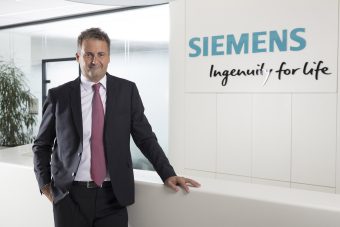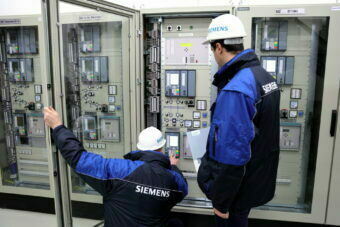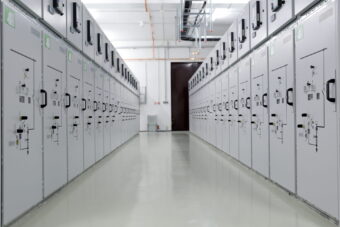
It has long been known that energy moves the world. In a literal sense, electricity and its sources move societies or threaten them when the energy flow is reduced. The competitiveness and prosperity of society are directly correlated with a stable and sustainable supply of electricity, and today we are increasingly talking about the role of energy in the process of decarbonization and the fight against climate change.
It is not easy to respond to the growing demand for electricity at a time when there is a global energy crisis and, at the same time to continuously reduce the emissions of greenhouse gases originating from the energy sector. For us to achieve this, this sector must be modernized and harmonized with all the achievements of modern society.
It is precisely the goal of the company Siemens Belgrade — to create a favorable environment for the smooth development of the energy sector that can respond to all emerging challenges.
Srdan Srdanović, Head of the Siemens Smart Infrastructure department, answered questions related to the development of energy infrastructure, the digitalization of the energy sector, and the challenges brought by the times we live in.
IN FOCUS:
- COMPLETELY ECOLOGICAL
- MORE WORKERS, MORE RECYCLED HAZARDOUS WASTE, A HEALTHIER ENVIRONMENT
- A BETTER LEGAL FRAMEWORK AND INCENTIVE MEASURES ARE A CONDITION FOR THE DEVELOPMENT OF THE RECYCLING INDUSTRY
EP: The Siemens department that you manage is called Smart infrastructure. What does Smart Infrastructure actually mean?

Srdan Srdanović: I believe there is some resistance to terms like “smart” because of their widespread use. That’s why we need to explain that thanks to smart infrastructure, which includes energy systems, meters and buildings, our cities will become better places to live in and greener. Smart infrastructure can reduce carbon emissions and energy demand and optimize energy supply. Demonstrating the purpose behind every “smart” idea, this infrastructure will be successful if consumers and companies stand behind the idea of digital energy transmission.
EP: What does your motto We create an environment that cares really mean?
Srdan Srdanović: Smart infrastructure supports what industries and organizations strive for; to be efficient, responsible, and smarter. Our company offers a wide portfolio of network control and automation, distribution of low-voltage and medium-voltage electricity, its redirection and control, and energy solutions. The portfolio is balanced in terms of all products, systems, solutions, and the entire range of services. Technology and human ingenuity unite and form a whole with our environment. If we want to take care of the world, the world must develop a new way of thinking about infrastructure. This means that it should reflect the needs and attitudes of modern society. In this sense, smart infrastructure supports how we all want to live — happily, comfortably, sustainably and in harmony.
EP: Where in Serbia has the smart infrastructure already been implemented?
Srdan Srdanović: We work with customers and partners in Serbia to create an ecosystem that intuitively responds to people’s needs and helps them achieve their goals. In the current health crisis, supporting the Clinical Center of Serbia, an institution that provides specialized health services for residents of the entire country, makes us especially proud. With the n-1 security principle implemented, the power supply is safe and reliable for our customers and patients. Smart infrastructure enables safe operation and tracking with real-time monitoring of every aspect of the energy su pply process and enables efficient operation of the Clinical Center of Serbia.

One of the projects is certainly the project of modernizing the medium voltage network in Serbia. Increasing the system’s reliability and ensuring that most customers are supplied with electricity in less than 30 seconds in the event of an outage in the city center was a big challenge for us. We delivered complete equipment for 30 substations and thereby enabled easy configuration and expansion of the system, but also reduced payments in terms of planned fines and provision of safe power supply to critical customers (hospitals, water supply, public transport, sensitive industrial production, public communication systems, etc.).
I would also add the flue gas desulfurization system for Thermal Power Plant Nikola Tesla A in Serbia. This factory was built in the 1970s, and today, it has to adapt to EU stan dards, especially concerning environmental protection. The new desulfurization system in the four blocks of TENT, A3, A4, A5 and A6 — with a capacity of 350 MW each, will enable this coal-fired power plant to operate for at least another 20 years following EU legal regulations.
EP: Due to the global energy crisis, the issue of energy transition is increasingly coming to the fore, and there is also the need to stop climate change. Is it possible to find technological solutions to these problems?
Srdan Srdanović: We live in times that are both fast and unpredictable, in which we depend a lot on circumstances in the world, but the fact is that advanced technologies are the answer to some of those changes. Innovation and digitization are key to completely redefining economies all over the world. A green, circular economy is not feasible without innovative solutions that will connect our real, physical world and the one we create in the digital domain. Siemens is one of the few technological leaders that brings those two worlds together, offering a synergy of hardware and software solutions that provide users with faster and more flexible operational processes. These smart solutions offer better productivity or infrastructure with efficient energy use.
Interviewed by: Milica Radičević
Read the story in the new issue of the Energy portal Magazine Waste Management.



